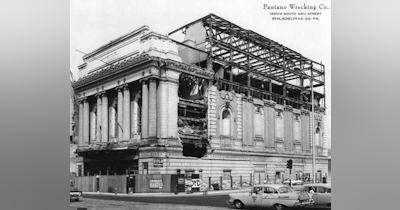In the newspaper advertisement, published in the Philadelphia Inquirer of November 1915, we can see how the movie The Birth of a Nation was marketed to the public.
In fact, the PR team for the film used techniques that any theater publicist of the time would have been familiar with - by bragging about how much money and effort had gone into making it. Going back to the days of circus men like Philip Astley, John Bill Ricketts and P.T. Barnum, telling the public that "no expense had been spared" was a sure fire way to pique public interest. Later on, large traveling minstrel show productions would use the same approach. And at the turn of the 20th Century, the spectacle Ben Hur assured the public that hundreds of people and horses and camels could be seen on the stage, just for one basic admission price.
People were often somewhat suspicious of circuses and plays, and many felt that if they wanted to get their money's worth for their tickets, after all, the fact that the producers had spent a lot of money - well, that was a quantifiable measure of its value!
Therefore, let me replicate the text that was in the advertisement, which may be a little small for many of you to read on your screens:
At the top left of the ad, we can see that the Forrest Theatre, which was built in 1907, was managed by Samuel F. Nixon - so it was under the control of The Theatrical Syndicate, nominally. The photo below left is of the front entrance on Broad Street, which opened on to a long narrow lobby which led to the theater building back in the middle of the block, between Sansom and Walnut Streets.
But as we shall learn in upcoming episodes, the Forrest had originally been constructed in a joint venture between The Syndicate and the Shubert Brothers, as an "Advanced Vaudeville" house that would challenge the Keith-Albee chain's dominance of the local vaudeville market. When that venture had failed a few years later, it had been converted to hosting touring light musical comedy production, like the George White's Scandals that we can see advertised on the image on the right, above. Before 1915, it had never really been used for movies.
Another interesting insight, I suppose, is that before the Forrest Theatre was built, that lot had been the location of the grounds of "The Yellow Mansion" or the Dundas-Lippincott House. This building, which was constructed on the site of the former Vauxhall Garden Pleasure Gardens, had been built in 1839. During the Civil War, the Lippincotts were seen as central supporters of the Confederacy in the City - that's why the Union League Club building was constructed directly across Broad Street from the house, to challenge it! So, in one way it's rather fitting that The Birth of A Nation was being exhibited there.
We can learn from the upper right corner of the ad that The Birth of a Nation was doing good enough business to offer TWO shows daily. Like most theaters showing plays, it offered different price levels - depending on how close the seats were to the screen. The best seats went as high as $1.50 and the cheapest were 25 cents.
Then - however much folks spent on the tickets - we can see the blandishments that boast of how much the producers spent on the movie, and how many people were involved in its creation. "18,000 people," "3000 horses," "5000 scenes [that] cast $500,000 [and] 8 months to produce"!
Other "facts" about the movie are in VERY small print at the bottom:
"Women's Dresses Used 25,000 Yards and Ku Klux Klan Costumes 12,000 Yards of Cloth."
"A Musical Score of 45 Pieces, Synchronized to the Several Thousand Distinct and Individual Scenes."
"Night Photography of Battle Scenes Invented and Perfected at Cost of $5000."
"A Series of Wild Ku Klux Klan 'Rides' that Commanded a County for Day and Cost $10,000."
"Ford's Theatre, Washington, Reproduced to the Smallest Detail for the Lincoln Tragedy."
"Biggest Battles of the Civil War Re-enacted."
"Cities Built Up and Then Destroyed by Fire."
"MAKING ALTOGETHER The Most Stupendous Dramatic Enterprise Which the Brain of Man Has Yet Visioned and Realized!"
"TO OUT OF TOWN PATRONS: You much see The Birth of a Nation in Philadelphia or NOT AT ALL this season. The route mapped out includes none of the smaller cities in the vicinity."
At the very bottom D.W. Griffith assures us that "The Birth of a Nation Will Never Be Presented in Any But the Highest Class of Theatres, at Prices Customarily Charged in Playhouses."
Selected Bibliography:
Baldwin, Bavarian L., ‘“I Will Build a Black Empire’: The Birth of a Nation and the Specter of the New Negro,” The Journal of the Gilded Age and Progressive Era, Vol. 14 (2015), pp. 599–603.
Biesen, Sheri Chinen, “Pre-Code Era” in Film Censorship: Regulating America’s Screen Account, Columbia University Press, 2018.
Fronc, Jennifer, “ 'Historical Presentation' or 'Libel to the Race'?”: Censorship and The Birth of the Nation,” The Journal of the Gilded Age and Progressive Era, Vol. 14, No. 4, (October 2015), pp. 612-164.
Thomas Dixon Jr. and the Birth of Modern America, Michelle K. Gillespie and Randall L. Hall, editors, Louisiana State University Press, 2006.
Witern-Keller, Laura, Freedom of the Screen: The Legal Challenges to State Film Censorship, 1915-1981, dissertation for the University of Michigan, 2003.











